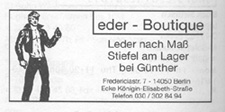Leather as a gay fetish
Sight, smell, feel, creak, and even taste. People use these words to describe the appeal of leather. All five senses seem to be used to 'register' the arousing effect of leather. Combined they make leather stand for masculinity, sexiness, and male bonding. To some (especially in the USA) the word "leather" even describes a whole life style that involves SM. Leather (the material) arouses people in very different ways. But really explaining why leather is arousing is almost impossible. You either understand, or you don't.
How people define themselves as leathermen is very different too. The same goes for wearing leather. Some follow very strict rules, others "just" wear leather clothing they like or find arousing. To some "leather" is only a part of their sexuality, to some it's their life.
On this page a number of men who -besides the influences we mentioned in the first chapter- were very important in the development of the image of the gay leatherman.
Tom Nicoll
The pioneer in portraying leather from a gay man's perspective was English photographer Tom Nicoll who started taking leather pictures even before 1950!


Photo's by Tom Nicoll, pioneer of leather pictures.
Above and below, four pictures by Tom Nicoll, these pictures were published from the mid 1950's. It is safe to assume that he was the first photographer to publish photo's with models wearing black leather. His speciality was the superb lighting on his pictures.
Some of Nicoll's pictures feature his own bike. No surprise when you imagine that his studios, Scott Studios, were located in his London garage appropriately (but coincidentally) at "Leather Lane"!
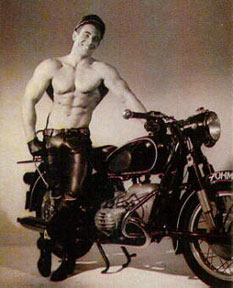
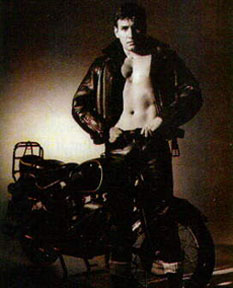
Photo's by Tom Nicoll, pioneer of leather pictures.
Nicoll published pictures of men in leather even before Tom of Finland published his art work of men in leather. In fact it is believed that he influenced Tom of Finland's view of leathermen. Introduced by Bob Mizer of Physique Pictorial, the two knew each other and Nicoll persuaded Tom of Finland to buy his first black leather jacket in the Summer of 1957 when he visited London.
In 1963, Nicoll moved with his studio to San Francisco but just one year later he stopped photographing and his studio was closed. A much regretted fact, for the pictures of this pioneer of leather photography were, and still are, beautiful.
Tom of Finland
Tom of Finland was already into leather in the 1940's, which was so early that he was initially wearing brown leather, at the time common for motorcyclists and men in the army. His early work shows mainly boots and sometimes leather jackets.
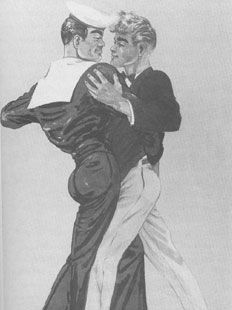
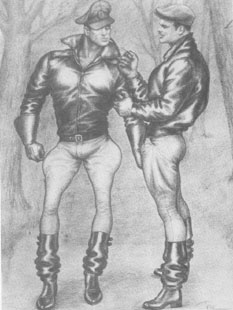
Early drawings by Tom of Finland.
Left: 1947. Right: 1954.
In the above drawing by Tom of Finland from 1947 there is not a trace of leather to be seen. But in the picture from 1954 there is and the leather is already that of the gay biker leathermen, not the earlier brown leather worn by pilots and motorcyclists.


Left: front cover of Physique Pictorial, Spring 1957.
Right: third page of that same issue.
The first two drawings of Tom of Finland were published in the Spring edition of Physique Pictorial in 1957. They were accompanied by the following text: "MEN OF THE FORESTS OF FINLAND is the theme of a new series of drawings being prepared by 'Tom' an artist who lives in Finland and draws directly from life. He is also going to show us a number of other rugged aspects of the rugged, physical culture minded men of Finland." This text was no doubt written by Bob Mizer who thus gave Tom the name "Tom of Finland" seemingly almost by accident. "Tom" was chosen because it came closest to the sound of Tom's Finnish first name which was "Touko". The "of Finland"-part followed naturally from the above sentence.
Peter Berlin
In 1973 the gay porn movie "Nights in Black Leather" was made. It featured Peter Berlin, who still is one of the most well known leathermen of that era. What is so special about this film is that it is clearly made by someone with a fetish for leather pants, something you rarely see in American material.

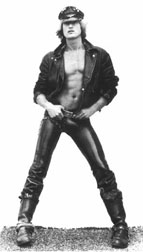
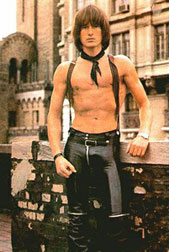
Peter Berlin, gay leather icon from the 1970's.
Pictures of Peter Berlin (he was indeed of German origin) are still attractive to a lot of people. They can be found all over the Internet.
Robert Mapplethorpe
Well known American photographer Robert Mapplethorpe also took pictures of men wearing leather. These pictures are from the late 1970's.


Robert Mapplethorpe
Left: self portrait, 1978. Right: Brian Ridley & Lyle Heeter, 1979.
Jim Wigler
San Francisco based photographer Jim Wigler took great pictures of leathermen from the 1980s on. The picture below was taken just before he started to work for Drummer Magazine in 1982. (See also our page 'Magazines'). Jim recalls taking pictures of "mostly every hot leather guy in San Francisco in the 1980s and 1990s". He kindly gave us permission to use this picture on our site.

Jim Wigler, early 1980s.
Getting Leather fetish gear
A very important factor for the appearance of gay leathermen was the availability of leather clothing itself. As can be read on the personal pages on this website it was sometimes hard to get the right items. Edward from Amsterdam went all the way to Hamburg in Germany in the late 1960's and Jason in London tried to obtain special leather items by mail in the USA in the late 1940's. In 1972 the English ad of Boy Studio appeared in a German magazine (picture further down on this page). The magazine was not only published in Germany but also in German. Moreover, the rest of the magazine was not at all aimed at leathermen. If it was interesting enough for an English company to advertise on the European continent, it is obvious that there weren't that many manufacturers of leather gear in Europe. At least not many companies that sold leather appealing to gay leathermen.
Leather gear for motorcyclists was readily available. But for leather of a more kinky nature leather fetishists had to find other leather shops who were willing to meet special requests. One of these, in Los Angeles, was started by a young Harley riding leather fan who learned to use a sewing machine and made a few items for himself. D. Lyn Sterling (born 1925) opened a small shop on Melrose, called The Leathermaker in 1960, when some of his friends asked him to make leather fetish items. His first success, was the creation of black leather chaps for bikers, styled after those worn by cowboys.

D. Lyn Sterling; The Leathermaker of Los Angeles.
Pictures of the 1960's.
Jason, at the time living in Los Angeles, tells us: "The Leathermaker claims to have been the originator of biker chaps, which were first made with a full length zipper on the inside of the leg. I can vouch for the fact that he DID make the first chaps with a zipper on the outside of the leg, because I ordered them from him in 1962, and I still have them. I remember that from those first orders and requests for new items, he began to design and make codpiece pants, hoods, masks and many other leather fetish items. Sadly, in 1987, the Leathermaker died suddenly, but many of his ideas were quickly copied by other shops, in many places, to meet the increasing market for fetish leather."
In the pictures above D. Lyn Sterling aka "The Leathermaker" is wearing some of his early chaps and other leathers he made for himself.
By the 1970's, new leather stores were opening in many of the large US cities to meet the demand from the new crop of young leather fans who were not bikers. Many of these were inspired by the early pop musicians in black leather, and later hard rock bands who adopted black leather as a trademark. Many of their outfits were definitely kinky in design. So owning at least a black leather jacket and then leather pants became commonplace.
|
Advertisements for leather gear.
In Amsterdam Rob Meijer opened the RoB Amsterdam leather shop in 1974. The shop has become legendary for its quality and design. It now has branches in London, Manchester and Berlin too, and could even be found in San Francisco for a time. Their gear is also sold in other shops in Brussels, Paris, Munich and Zurich. In a number of cities one person firms were established in the 1970's. "Leder - boutique bei Günther" in Berlin for instance (see picture above). A lot of those one man shops stopped when the owner and leather craftsman retired or was unable to continue the shop for another reason. In the case of RoB the company survived Rob Meijer's death in 1990, because it had already become much larger.

RoB Amsterdam, English black and white advertisement late 1980's.
On top of that left: front of the shop and right: 4 of the 5 catalogues RoB issued.
Because there were not that many shops a lot of customers lived too far from the shops to visit them. Many of the shops had catalogs that could be ordered by mail and so could the merchandise. When the Internet really broke through in the late 1990's most catalogs were soon replaced by a website.
Attitude
For some reason there seems to be a different attitude towards leather in Europe and America. "Leathermen" in Europe wear leather pants and jackets, without very strict rules. In the US you are considered a leatherman if you lead a certain lifestyle, not necessarily in leather pants and mostly in an SM style.


Left to right: Glenn Hughes the original 1970's Village People Leatherman.
Cover of the Leatherman's handbook (1972) and a typical 1980's leatherman.
This is consistent with the description in the American "Leatherman's Handbook", by Larry Townsend (1930-2008), first published in 1972, who describes leathermen as men with "toys, belts, boots, jackets and" ... "blue jeans". To us this is very surprising. A lot of gay men in Europe consider leather pants to be the most essential part of the leatherman's outfit. Fortunately a lot of the leathermen in the US (and elsewhere) cover the blue jeans with leather chaps. The modern motorcycle style chaps that gays wear were modeled after the ones the cowboys wore.
The image of a leatherman has almost turned into a cliché now. Two Dutch artists made series of pictures portraying dress codes from different subcultures, one of those was a series called "Leathermen".


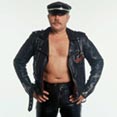

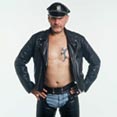



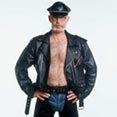
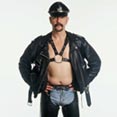

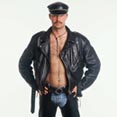
Rotterdam 1998, "Leathermen".
In the 21st century the Internet has become a major influencing factor for leathermen too. The Internet provides pictures and video to copy the style from and the specific social networks give access to all sorts of opportunities to meet and date each other. It has taken over the role of contact ads and bars in a way. In the following pages we look at how leathermen used to meet each other in the old days.



